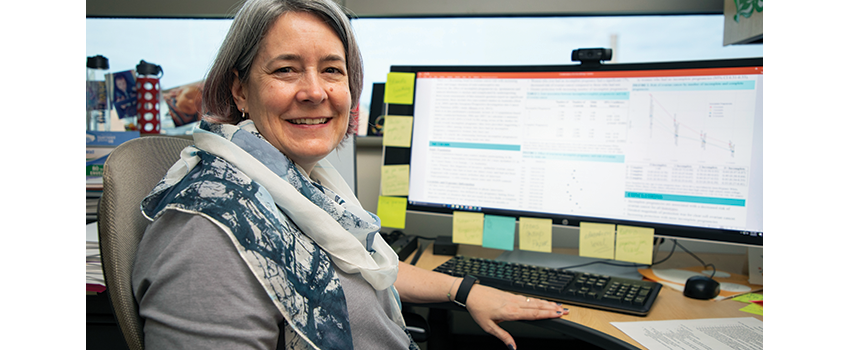MI-CARES
Contributed by Nicole Fawcett
Rogel investigators bring collaborative expertise to understanding statewide environmental exposures and cancer risk

Credit: Michigan Medicine
Celeste Leigh Pearce, Ph.D., M.P.H., wants to build more than a cohort of study participants. She wants to create a movement. It’s a movement to understand how exposures to toxic metals, industrial pollution and “forever chemicals” called PFAS are impacting the health and cancer risk of residents across Michigan.
Specifically, she wants to recruit at least 100,000 Michiganders ages 18-49 from diverse racial and ethnic backgrounds, with a focus on those who live in environmental injustice hotspots such as Metro Detroit, Flint, Grand Rapids, Kalamazoo, Lansing and Saginaw.
“As a cancer epidemiologist, the opportunity to put together a cohort that really has the potential to help us understand these important exposures is the pinnacle of what we do,” says Pearce, co-principal investigator of the Michigan Cancer and Research on the Environment Study, or MI-CARES.
She is equipped with a $13 million grant from the National Cancer Institute and an expert team of collaborators from the Rogel Cancer Center and the University of Michigan School of Public Health, including co-principal investigators Bhramar Mukherjee, Ph.D., and Dana Dolinoy, Ph.D.
Pearce, professor of epidemiology at the School of Public Health and co-lead of Rogel’s cancer control and population sciences program, reflects on the project and why bringing this study to Michigan is so critical.
This is an ambitious project with a huge scope. How did it come together?
When we read the request for funding, it was really clear that Michigan was the right place to study environmental exposures and cancer risk. Michigan has had many environmental catastrophes over the decades, the most recent being PFAS and hexavalent chromium releases into the Huron River.
We also have the right people here at the Rogel Cancer Center and School of Public Health to do this work, which made it easy to put a team together with all the relevant expertise.
In terms of size, we knew that to understand these associations, we would need a lot of people. I worked on the multi-ethnic cohort study of diet and cancer at my previous institution, which included more than 200,000 people, so I had experience and comfort with building a large cohort. We decided, go big or go home.

Credit: Michigan Medicine
How do you feel about that now that you’ve gotten started?
It’s certainly daunting! We enrolled more than 1,200 people in the first three months, which we feel good about. As we get the word out and find what recruitment strategies work best, we’ll engage more communities and continue to enroll. It’s about helping people understand the goals and value of the cohort but also refining our understanding of communities’ needs so we can give back in a way that’s meaningful to them. We want to make sure we’re not just asking participants to engage but also engaging back ourselves.
How big of a problem are environmental exposures in Michigan? Why is it the place to do a study like this?
We can go all the way back to a statewide environmental exposure in the early 1970s when there was a contamination of animal feed with fire retardant. The contaminated feed was distributed all over the state and fed to animals, some of whom were slaughtered. People consumed those products and were poisoned. There are ongoing studies of the health effects of that contamination and evidence of increased risks of some cancers.
That happened almost 50 years ago, but we look back closer in time at the Flint water crisis. The health consequences there are far reaching – of course lead contamination, but we don’t yet have a full understanding of all the health effects.
Then there’s the Tri-Cities area of Midland, Saginaw and Bay City, as well as the River Rouge communities in Metro Detroit, which have some of the highest pollution levels in the country.
You identified six environmental injustice hotspots and plan to recruit equal numbers of Black, Hispanic, Middle Eastern and North African (MENA) and white participants. What role do racial disparities play in environmental exposures and cancer risk?
When you look broadly at exposures, communities of color are largely affected. This presents an opportunity to try to understand disparities in exposures, including across neighborhoods. In Michigan, you can see pockets of environmental injustice, which is where we are targeting our enrollment.
One important aspect of the cohort is that for the first time we’ll be able to look at exposures and outcomes in the MENA community. This is often described as a hidden community because, historically, questionnaires have not asked whether people are of MENA descent. Our cohort will allow people to identify as MENA, which will give us the opportunity to understand potential health disparities in this community.
What makes this study unique?
MI-CARES is not a one-time questionnaire. Participants will give us information every year, through surveys. At the time of initial enrollment, we are also asking people to donate blood and saliva samples. It will help us understand the association between these environmental exposures and intermediate cancer markers, such as stress, inflammation and immune function. Eventually, we’ll also be able to look at cancer incidence.
Our goal is to be able to look across the lifespan at critical time periods – birth, school age, puberty, young adulthood, pregnancy, menopause. To do that, you need to use a cohort, not look retrospectively, because you’re capturing it in real time. This life-course approach is one of the study’s key design points.
What do you hope comes from this study?
It will give us a sense of exposure distributions across communities in Michigan and help us understand differences based on racial or ethnic group and neighborhood characteristics. We also will look at the impact of environmental exposures on immune function and biologic aging. Are these exposures causing our cells to age prematurely, which could lead to cancer or other diseases?
Another opportunity is to establish smaller cohorts of cancer patients or survivors to look at environmental exposures, survival and quality of life outcomes. That’s in the works for 2023.
On a broader level, I hope it’s an opportunity to inform policy. The regulations around environmental pollution in Michigan and most states tend to favor businesses over individuals. Let’s say there are three plants in a community all putting out pollution. If one plant asks for an override of their allowable pollution amount, the approval is based only on an evaluation of that one plant. It doesn’t look at the cumulative exposure from all three plants. Right now, only New Jersey has passed legislation that looks at cumulative exposure. New York is also considering it. I would love to see legislation like this in Michigan. That’s outside the scope of the cohort, but findings from the cohort can inform the policy and advocacy discussions.
At the end of the day, what I hope to show is how Michigan as a statewide community can come together and really get answers by participating in this cohort.
Learn more about MI-CARES at micares.health.
Continue reading Illuminate, 2023 or download the print version.
